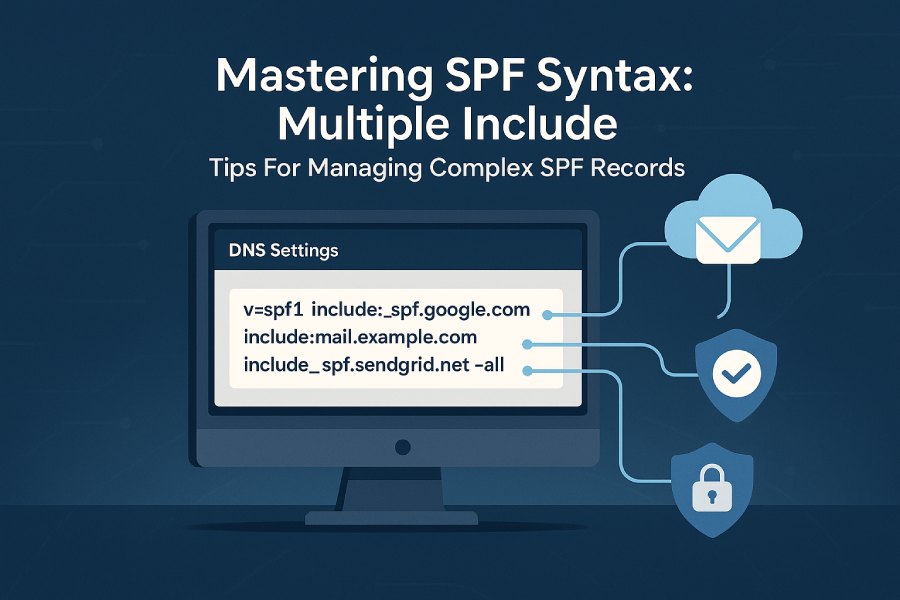Sender Policy Framework (SPF) is a critical email authentication protocol designed to prevent email spoofing by specifying which mail servers are authorized to send emails on behalf of a domain. Implemented as a DNS TXT record, an SPF record holds SPF syntax directives that guide receiving mail servers—such as those operated by Microsoft, Google, and Amazon Web Services—on how to evaluate incoming messages.
This evaluation, known as SPF evaluation, determines whether an email should SPF pass, SPF fail, SPF softfail, or be marked as SPF neutral, contributing significantly to SPF email deliverability and overall email authentication standards.
Defined originally in RFC 7208 by the Internet Engineering Task Force (IETF) and refined by the Sender Policy Framework (SPF) Working Group, the SPF record syntax consists of SPF directives and SPF mechanisms. Common mechanisms include `a`, `mx`, `ip4`, `ip6`, `exists`, and the pivotal `include` mechanism. The SPF syntax dictates how these mechanisms, along with SPF qualifiers (such as `+`, `-`, `~`, `?`), are composed to allow or restrict authorized sending IPs.
The Role of the ‘include’ Mechanism in SPF Syntax
Among the collection of SPF mechanisms, the `include` mechanism plays an indispensable role in expressing complex DNS SPF policies, especially for domains that employ multiple third-party email providers or send mail through various platforms like SendGrid, Mailchimp, Salesforce, or Rackspace. The `include` directive allows an SPF record to incorporate the SPF record of another domain. For instance, utilizing `include:spf.protection.outlook.com` enables Microsoft 365’s SPF policies within the domain’s record.
This modularity simplifies administration by avoiding direct listing of all IP addresses and instead defers to trusted DNS SPF policies. However, the usage of the `include` mechanism must align with strict SPF syntax guidelines, avoiding potential SPF syntax errors and ensuring compliant SPF validation.
When and Why to Use Multiple Includes in SPF Records
Complex email infrastructures often require the use of multiple include statements within a single SPF record. Domains that simultaneously use Google Workspace, Cloudflare for DNS, and Proofpoint for email security solutions — or businesses integrating Amazon Web Services alongside third-party marketing platforms like Mailchimp — rely on including SPF policies from each respective provider.
Using multiple includes efficiently supports:
- SPF email spoofing prevention by authorizing all legitimate sources.
- Managing diverse sending sources without expanding the SPF record excessively.
- Enhancing SPF alignment with DMARC policies, critical for providers like Yahoo, Facebook, and LinkedIn that enforce strict SPF strict syntax standards.

The adoption of multiple includes also accommodates dynamic infrastructures where SPF updates from external providers are automatically incorporated without manual record changes, crucial for domains hosted by GoDaddy, Bluehost, or Alibaba Cloud.
Common Challenges of Managing Multiple Includes
Despite its advantages, managing SPF records with multiple includes introduces several challenges that administrators must navigate:
- SPF DNS Lookup Limit: The SPF standard limits DNS lookups to a maximum of 10 during SPF lookup, including lookups triggered by `include` mechanisms and nested includes. Domains approaching or exceeding this SPF record limit may experience SPF fail or incomplete SPF evaluation, impacting email delivery.
- SPF Record Length and Complexity: Excessive includes can inflate the SPF record length, leading to oversized DNS TXT records that cross vendor-imposed limits or cause SPF syntax errors. Some DNS providers like Cloudflare and Akamai impose constraints on SPF record TTL and propagation speeds.
- SPF Nested Includes and Include Chaining: Includes that themselves contain further includes (nested includes) exponentially proliferate DNS queries, complicating SPF record troubleshooting and risking surpassing DNS query limit or hitting SPF DNS lookup limit.
- SPF Modifiers Interaction: Elements such as `redirect` or the recently discussed `exp` modifiers require precise positioning within the SPF record, or they risk conflicting with multiple includes, producing ambiguous SPF semantics.
- Propagation Delays and Configuration Errors: Propagation delays in DNS updates (SPF DNS propagation), combined with frequent SPF record alterations, can cause inconsistent SPF record deployment states affecting providers like ProtonMail or Fastmail.
- Security Considerations: Inefficient management of includes might unintentionally authorize malicious IPs or outdated services, compromising SPF security and undermining SPF email spoofing prevention goals.
Providers such as Valimail, Dmarcian, Agari, and OpenSPF offer powerful SPF record testing and validation tools to assist in identifying such issues.
Syntax Rules for Properly Using Multiple Includes
Adhering to strict SPF syntax guidelines is paramount when working with multiple includes to ensure compliance with RFC 7208 and optimal email deliverability:
- One SPF Record Per Domain: Only a single SPF record (one DNS TXT record) should exist per domain to avoid SPF syntax error or version conflicts. Instead of multiple TXT records, consolidate into one record with multiple `include` mechanisms, e.g., `v=spf1 include:_spf.google.com include:spf.protection.outlook.com -all`.
- Correct Use of Qualifiers with Include: Each `include` mechanism inherits the overall record’s SPF qualifiers (`+`, `-`, `~`, `?`). Using improper qualifiers can trigger SPF softfail or unintended SPF neutral results.
- Limit the Number of Mechanisms and Includes: Keep the total SPF mechanism count, including all nested includes, well below SPF DNS lookup limit of 10 to prevent runtime lookup failures.
- Avoid Include Chaining and Deep Nesting: Instead, prefer SPF flattening techniques, which involve generating a single-level SPF record listing all authorized IPs resolved from includes, thereby reducing lookup dependency.
- Handle Macros Appropriately: When needed, use SPF macros carefully in includes to account for dynamic IPs or domains without breaking SPF syntax parser processes on receiving servers.
- Use Explicit “-all” or “~all” Modifiers: Conclude SPF records with SPF-all modifiers to explicitly specify actions for non-matching IPs—either fail hard (`-all`) or softfail (`~all`) to guide consistent SPF evaluation.
- Regularly Test and Validate: Employ tools provided by companies like Cisco, Barracuda Networks, Mimecast, and Proofpoint to verify your SPF syntax, diagnose SPF record troubleshooting issues, and validate that your SPF policy does not produce SPF syntax error or validation warnings.

Following these best practices ensures robust SPF record management, efficient SPF record optimization, and hence sustained SPF email deliverability and comprehensive email authentication security for domains leveraging multiple email platforms and providers such as Tencent, Zoho Mail, and Salesforce.
Impact of DNS Lookups on Multiple Include Mechanisms
The Sender Policy Framework (SPF) relies heavily on DNS TXT records for email authentication, with each SPF evaluation requiring multiple DNS lookups when the SPF record contains multiple include mechanisms. Each `include` directive triggers an SPF lookup on the referenced domain’s DNS TXT record, effectively expanding the number of DNS queries during SPF evaluation.
A significant consideration is the SPF DNS lookup limit, officially capped at 10 DNS queries per SPF check as per RFC 7208. When using multiple includes—such as including popular third-party providers like Google, Microsoft, Amazon Web Services, or Proofpoint—this limit can be quickly exhausted. Due to SPF nested includes or include chaining, where an included record contains other includes, the DNS query count can escalate unexpectedly. This not only risks SPF fail results but also impacts SPF email deliverability by causing SPF softfail or SPF neutral outcomes in the presence of strict SPF syntax validation by modern receivers, such as those operated by Yahoo, LinkedIn, or Zoho Mail.
Strategies to Optimize SPF Record Length and Complexity
Given the SPF record limit in both length and DNS queries, optimization is crucial for maintaining SPF record security and performance. Organizations like Barracuda Networks, Agari, and Dmarcian advocate for SPF record flattening—a technique that replaces include mechanisms with their resolved IP addresses—to minimize DNS lookups during SPF evaluation. However, this method must be managed carefully, as IP addresses in flattened SPF records might become outdated, requiring regular updates to ensure SPF record accuracy and SPF security.
Another strategy involves carefully selecting which third-party include mechanisms to incorporate. For example, Mailchimp, SendGrid, or Salesforce may have overlapping IP ranges, allowing consolidation or selective inclusion to reduce SPF mechanism count. Limiting SPF modifiers and qualifiers reduces complexity and risks of SPF syntax errors, ensuring SPF strict syntax compliance and easier SPF record troubleshooting.
Additionally, using SPF macros sparsely helps prevent unintended SPF syntax errors while allowing some dynamic IP matching where necessary. Keeping SPF record length under the DNS TXT record size thresholds and optimizing the SPF record TTL to balance propagation timing and frequency of updates is key for SPF record management and SPF record best practices.
Tools for Validating and Testing SPF Records with Multiple Includes
Thorough SPF record testing prior to deployment is crucial, especially when multiple include mechanisms exist. Tools from vendors like Valimail and OpenSPF provide sophisticated SPF syntax parsing and SPF validation to identify SPF syntax errors, nested include issues, or SPF DNS lookup limit breaches.

DNS query analyzers and SPF syntax parsers built into platforms by Cisco, Mimecast, and Proofpoint offer SPF record optimization insights, showing how SPF directive order affects SPF evaluation results. SPF record testing tools simulate SPF lookup processes to determine SPF pass, SPF fail, SPF softfail, or SPF neutral outcomes based on the current DNS SPF policy.
Google’s and Microsoft’s email security portals also offer native SPF record checking within their SPF configuration UI, enabling organizations to validate SPF record deployment and SPF record propagation status with real-time diagnostics.
Handling SPF Record Limits: 10 DNS Lookup Restriction Explained
The 10 DNS lookup restriction remains one of the most critical SPF record constraints. This limit prevents excessive DNS queries that could lead to delays in SPF evaluation or DNS-related failures. Each include mechanism, `a`, `mx`, or `ptr` mechanism, counts as separate lookups in the SPF mechanism count. Nested includes amplify the problem further.
Service providers like Cloudflare and Akamai recommend reducing the number of included SPF domains by consolidating or removing unnecessary third-party email sources. Tools to monitor DNS query limits during SPF record updates, provided by vendors like Symantec and Barracuda Networks, assist in avoiding SPF record length bloating and DNS SPF policy violations.
When the lookup limit is exceeded, SPF evaluation must return SPF permerror or SPF fail, risking email rejection or delivery to spam folders. Therefore, it’s essential to conduct rigorous SPF record troubleshooting and adhere strictly to SPF syntax guidelines during configuration.
Best Practices for Combining Third-Party SPF Includes
Integrating multiple third-party SPF includes requires careful planning, as overlaps and redundancies are common. Leading cloud and email service providers such as Amazon Web Services, Salesforce, and Rackspace provide SPF record examples multiple include that outline their recommended SPF syntax and directives for streamlined email authentication.
To manage SPF include chaining effectively, using selective include mechanisms rather than blanket `include:` statements keeps SPF semantics clean. Employing SPF record examples from providers like Zoho Mail, Fastmail, and ProtonMail* can offer templates aligned with SPF record best practices.
Adopting SPF record optimization techniques—such as monitoring SPF record length, avoiding excessive SPF modifiers, and regularly validating SPF records post-deployment—ensures SPF email spoofing prevention without compromising email deliverability. Entities like GoDaddy and Bluehost also emphasize the importance of maintaining SPF record propagation consistency to avoid intermittent SPF validation failures.
Troubleshooting Common Errors with Multiple Include Usage
Errors commonly encountered with multiple include usage in SPF records often revolve around SPF syntax errors and exceeding DNS lookup limits. SPF syntax errors frequently stem from incorrect use of SPF qualifiers (`+`, `-`, `~`, `?`) or modifiers (like `redirect=`), which can cause SPF evaluation to end prematurely or produce ambiguous results such as SPF neutral.
Insufficient SPF record testing may lead to SPF softfail or SPF fail conditions during email processing, which anti-spoofing gateways from Proofpoint or Mimecast might block or quarantine. SPF record troubleshooting begins with careful SPF validation using SPF syntax parsers to detect SPF syntax errors, unresolvable SPF includes, or SPF nested includes that violate SPF strict syntax guidelines.
Issues like SPF record propagation delay, caused by improper SPF record TTL settings, can cause inconsistent SPF evaluation results across different receiving mail servers (e.g., Facebook or Tencent). Monitoring SPF DNS propagation using SPF record testing tools helps identify these timing-related issues swiftly.

Furthermore, frequent SPF record updates, especially in environments with third-party partnerships such as Alibaba Cloud or SendGrid, require consistent record management to prevent breaking SPF alignment. Incorporating automated SPF record management tools from vendors like Agari or Dmarcian helps mitigate human error by enforcing SPF syntax guidelines and maintaining SPF compliance with evolving DNS SPF policies.
By addressing these areas, organizations improve their SPF record deployment, reinforce SPF email spoofing prevention, and maintain robust email authentication frameworks recognized by major providers including Microsoft, Google, and Yahoo.
The Relationship Between SPF, DKIM, and DMARC in Email Authentication
SPF (Sender Policy Framework), DKIM (DomainKeys Identified Mail), and DMARC (Domain-based Message Authentication, Reporting, and Conformance) form the triad of modern email authentication protocols that collectively bolster email security and integrity. Understanding how these standards interoperate is essential to comprehensive DNS SPF policy deployment and effective email spoofing prevention strategies.
SPF validates whether an email originates from authorized IP addresses as specified in a domain’s DNS TXT record. This is executed through SPF evaluation and SPF lookup processes guided by SPF syntax defined in RFC 7208. The SPF record uses SPF directives such as include mechanism, a, mx, ip4, and modifiers like redirect to list authorized sending sources. A successful SPF pass indicates alignment between the sending IP and the SPF record, thereby reducing fraudulent email delivery.
DKIM, by contrast, provides message integrity through cryptographic signatures attached to outbound email headers. Email recipients validate these signatures using public keys published in DNS TXT records. Where SPF is IP-based authentication, DKIM ensures that email content remains unaltered during transit, enhancing SPF record security when used in conjunction.
DMARC sits atop SPF and DKIM to provide policies for how receivers should handle messages failing SPF or DKIM checks. It also enforces SPF alignment, requiring that the domain in the RFC 5321.MailFrom (used in SPF evaluation) aligns with the domain in the RFC 5322.From header, providing greater protection against spoofing. DMARC policies enable domain owners to instruct receivers whether to reject, quarantine, or monitor emails, alongside reporting capabilities.
Prominent email service providers such as Microsoft and Google have deeply integrated SPF, DKIM, and DMARC into their email ecosystems to improve SPF email deliverability and mitigate spam. Organizations like Agari and Dmarcian offer tools for SPF record troubleshooting, SPF validation, and alignment monitoring, ensuring that enterprises maintain stringent SPF configuration and record management for enhanced email security.
Case Studies: Real-World Examples of Complex SPF Records
Complex SPF records often arise when organizations use multiple third-party vendors or email sending services/ infrastructure, necessitating multiple include mechanisms and SPF modifiers in their DNS TXT records. Let’s examine several case studies illustrating how these complexities manifest.
Case Study 1: Large Multinational Corporation
A company like Salesforce or Amazon Web Services hosts multiple sending services across different regions. Their SPF record must include several nested includes (SPF nested includes) to authorize all legitimate senders. However, exceeding the SPF record limit, particularly the DNS query limit of 10 SPF DNS lookups as noted in the SPF RFC 7208, is a common challenge. The company uses SPF flattening techniques combined with SPF syntax parsers to optimize SPF record length and mechanism count, preventing SPF syntax errors and reducing lookup delays during SPF evaluation.

Case Study 2: Managed Email Security Provider
A vendor like Proofpoint or Barracuda Networks manages outbound email filtering for various customers, requiring SPF records with chained include mechanisms (SPF include chaining). Their SPF record example includes multiple include entries such as include:customer1.com, include:customer2.net, and so forth. Managing DNS SPF policy for each client requires rigorous SPF record best practices, including domain delegation and distinct SPF qualifiers (-all, ~all, ?all), to handle SPF fail, SPF softfail, and SPF neutral results effectively.
Case Study 3: Small Business with Third-Party Email Marketing
Mailer services like Mailchimp or SendGrid often necessitate domain owners to add multiple includes into the SPF records. For instance, a Zoho Mail user who also sends through Mailchimp and Amazon SES must incorporate multiple include mechanisms accurately, adhering to SPF syntax guidelines. A typical SPF record example might be:
`v=spf1 include:zoho.com include:servers.mcsv.net include:amazonses.com -all`
This multi-include scenario highlights the importance of SPF record testing tools provided by entities such as OpenSPF and Valimail for validation and deployment.
Maintaining and Updating SPF Records Over Time
Maintaining SPF records is an ongoing process crucial for sustaining SPF email spoofing prevention and ensuring SPF email deliverability. Factors necessitating updates include adding or removing email service providers, reacting to changes in IP ranges, or resolving SPF syntax errors identified through SPF record troubleshooting.
SPF Record TTL and DNS Propagation
SPF record TTL (Time To Live) settings influence how quickly changes propagate across DNS servers. Providers like GoDaddy, Bluehost, and Cloudflare offer user-friendly interfaces to modify DNS TXT records with SPF syntax, facilitating prompt SPF record propagation and minimizing configuration delays.
SPF Record Management and Optimization
To comply with SPF DNS lookup limits and avoid SPF fail scenarios, domain owners should regularly audit SPF mechanisms and includes. SPF record optimization techniques such as SPF flattening reduce the number of DNS lookups by consolidating IP addresses directly into the SPF record. Regular SPF validation using SPF syntax parsers and tools from vendors like Symantec and Mimecast help detect common issues such as SPF syntax errors or invalid SPF macros.
Version Control and Documentation
Best practices recommend maintaining documentation of SPF configuration changes, supported by SPF record testing during deployment. Cloud-based services like Salesforce and Rackspace facilitate this approach with change logging and version control, ensuring DNS SPF policy integrity over time.

Future Trends and Updates in SPF Syntax and Usage
The Sender Policy Framework remains a pivotal email authentication standard, but it faces evolutionary challenges and opportunities consistent with modern email infrastructure.
Technical Enhancements and RFC Updates
Ongoing efforts from the SPF Working Group within the Internet Engineering Task Force (IETF) focus on refining SPF syntax and semantics. The future may incorporate expanded SPF macros for more dynamic DNS TXT records, better handling of SPF include chaining complexities, and enhancements to SPF qualifiers and modifiers for more granular policy expressions.
Improved SPF Record Management Tools
Enterprises increasingly rely on automated SPF record management systems from leaders like Valimail, Agari, and Dmarcian. These platforms offer intelligent SPF syntax parsers, SPF record optimization advisory, and SPF record troubleshooting with advanced SPF evaluation diagnostics, facilitating compliance with SPF record best practices.
Integration with Other Authentication Protocols
Future SPF deployments will likely feature tighter integration with DMARC and BAM (Brand Indicators for Message Identification), further strengthening SPF alignment and overall email security. Innovations could also enhance SPF record deployment workflows, with cloud DNS providers such as Akamai, Tencent, and Alibaba Cloud offering seamless SPF DNS propagation capabilities.






